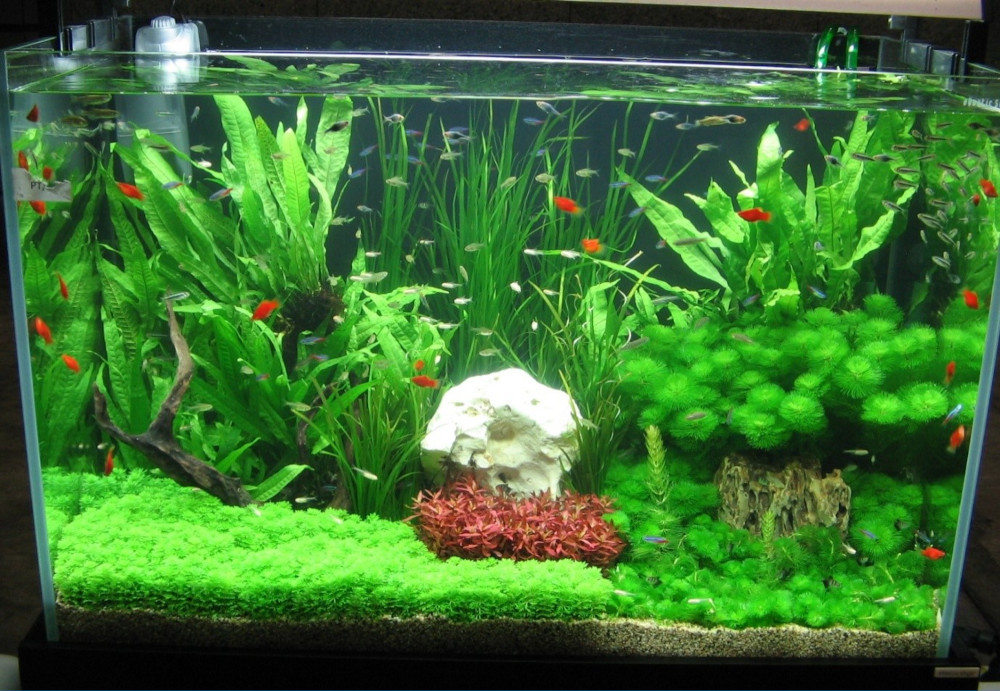How should I care for my tropical fish?
Tropical fish are very popular aquarium fish due to their colour and variety. They originate from many regions of the world. The following information will help to improve your fish longevity, health, and welfare.
Purchasing healthy tropical fish
When purchasing tropical fish, first check that the seller is reputable and that their aquariums are not overcrowded. Purchasing from a large aquarium store will generally be a good option. Healthy fish display clear and bright body colouration, and they hold their fins erect. Healthy fish are also alert and swim without undue effort.
Indicators of poor health include fish that sink or bob to the surface; fish that have lumps, bumps, wounds, clamped fins, or a trail of excreta (faeces) and fish that stay in a corner of the aquarium for a prolonged period of time.
In most tropical fish aquariums, there will be several different types of fish. It is important to make sure that the different types of fish you have are compatible with each other. Do some research (reputable internet sources are very useful) and seek guidance from the aquarium store before your purchase any new fish to ensure compatibility.
Aquarium size
You will need to consider how large your fish will be when they reach adult size and the total number of fish you wish to keep. The larger the tank and filter (see below), the better it is for your tropical fish. The minimum tank volume should be 50 litres.
With some species of tropical fish such as the livebearers e.g. guppies, there can be prolific breeding and this needs to be considered when establishing your aquarium. The more the fish you have, the larger your tank will need to be.
Heater and thermometer
Tropical fish are from tropical climates, so heating is essential. The tank should be heated using a submersible aquarium heater and the temperature maintained between 24 to 26°C. Normal room temperature is not suitable as is generally too cold, and can also fluctuate, which can be stressful to the fish.
Small fish bowls are too small to fit a suitable heater and thus cannot properly regulate and maintain a constant temperature. Some bowls/tanks are sold with small lamps above them, suggesting that this will provide adequate heat. However, these lamps are usually switched off at night and the heat provided may be either insufficient or excessive depending on the surrounding area/climate the bowl is kept in.
A submersible aquarium heater is the only way to achieve and maintain a constant and appropriate temperature for your tropical fish.
Water quality
Good water quality is essential for any aquarium and is the key to keeping your fish healthy. Regularly test your water for ammonia, nitrite, and nitrate levels to ensure your biological filtration is working, you are maintaining it appropriately and your aquarium is not overstocked or over fed.
Other water parameters to monitor include pH and water temperature.
Ideal water parameters for most tropical fish are:
- Ammonia < 0.1 ppm
- Nitrite < 0.2 ppm
- Nitrate < 50 ppm
- pH 6.5 to 7.5
- Temperature 24 to 26°C
When starting a new aquarium, until the Nitrogen Cycle is established, test the water every two to three days for ammonia and nitrite for the first six weeks. After this testing every one to two weeks is sufficient.
Further information and videos are available at Aquarium Care 101 (Aquarium School / The Aquarium Vet).
Filtration and aeration
It is important to have efficient filtration of a suitable size to maintain water quality and for aeration. Good filtration will ensure all water is regularly filtered mechanically and biologically via the nitrifying bacteria in the filter media, which convert the toxic ammonia released from decaying fish waste into less harmful nitrates. If the filter does not create bubbles or stir the surface water, aeration with an air stone is needed to ensure that the water is well oxygenated.
Water maintenance
Weekly partial water changes of 10 to 25% of the tank water are recommended combined with a gravel clean to remove waste and to help your goldfish remain healthy.
A gravel siphon purchased from a pet store should be used. Gently shake the siphon briefly in the aquarium to start the flow of water into a bucket below. Use a dedicated (labelled) fish bucket which will not be used for other purposes to avoid any harmful chemical residues. The end of the siphon in the tank can be used to clean the gravel by vacuuming the substrate to remove fish faeces and any uneaten food. Fish can stay in the aquarium while siphoning to minimise stress, though care should be taken not to move too rapidly as this may stress the fish.
NEVER suck on the hose to start a siphon as this can cause human health issues.
After 10 to 25% of the water is drained, replace the water with cold tap water. It is worth having a second bucket that was filled the day before with tap water. This allows some of the chlorine to gas off and also brings the water temperature up to room temperature. Before adding this new water, it is very important to add the appropriate quantity of an aquarium Water Conditioner (sometimes called water agers) to neutralise the chlorine and chloramine present in the tap water. Carefully read the label of the product that you are using.
Handy tip: use the old aquarium water on your plants. It is a great fertiliser.
The filter should be rinsed lightly in a bucket of tank water when it starts to get clogged up or on a monthly basis (whichever occurs first). It is important to avoid over-cleaning the filter media as this will remove the beneficial bacteria. Without beneficial bacteria in the filter, ammonia from fish waste will not be broken down to less harmful nitrates, leading to fish death. Do not use tap water to clean the filter, as the chlorine (or chloramines) may also kill the beneficial bacteria.
The inside of aquariums can be cleaned of any algae build-up by wiping the insides gently with a clean, aquarium safe sponge or with a magnetic glass cleaner. Never use soap or detergents when cleaning an aquarium.
Periodically altering the direction of water flow in your aquarium, will also provide some environmental enrichment for your tropical fish.
Plants and decor
Some tropical fish species are prey animals and thus require adequate plant cover to prevent stress and facilitate activity. Approximately 50% cover is recommended, with some areas of plants close together and then some open areas of the tank. The more cover provided, the more active your fish will become, and plants also provide environmental enrichment.
It has been shown that artificial plants are as effective as real plants from a stress-reduction viewpoint [1]. However, live plants have the added benefit of absorbing waste products from the water. Only source live plants from an aquarium store. Do not collect from the wild as you may introduce parasites or disease into your aquarium. Also only use plastic plants purchased from an aquarium store.
Driftwood and other decorations may also provide cover. Ensure that any tank decor is free from sharp or rough edges that may injure your fish or any small holes in which they may become trapped as they grow larger.
Regardless of the shape, all tanks should have a covered area/side where the fish are not exposed to bare glass. This provides promotes better welfare for your fish, as they will be less stressed and feel more secure.
Lighting
To minimise algae outbreaks, aquariums should ideally be kept away from direct sunlight or windows. Aquarium lights should be left on for a maximum of 10 hours a day.
It is also important that your fish have a minimum of eight hours of darkness, so make sure all lights or lamps are turned off at night in the area that your aquarium is located.

An ideal tropical fish aquarium set up.
Feeding
The most common problem with all fish is overfeeding, leading to obesity and other health issues. Uneaten food also breaks down and contaminates your aquarium. Feed your fish once a day and only what can be eaten in under two minutes. If you have more than one fish feed in two or more separate areas to make sure all fish eat the food.
A varied diet will maximise the health of your fish. A mixture of specialised tropical fish flake and granules (small pellets) is ideal. Make sure that food is stored in a cool place and discard any food not eaten within one year of opening the container.
Occasionally supplementing with frozen black worms, brine shrimp, tubifex worms and daphnia, will offer a varied diet and provide some enrichment.
Mammalian fats (e.g. from beef heart, meat, offal) are poorly digested in fish, and should not be fed to fish.
Emergency preparedness
Unfortunately, there is always the possibility that you will need to move or transport your fish in an emergency. This may be because the tank develops a leak or a more serious emergency such as fire or flood. Being prepared for such an emergency is important as transporting your fish safely requires specific equipment and preparation and the survival of your fish can depend on this. For information on preparing an emergency fish transport plan and kit, see this article.
For more information, it is recommended that you talk to an experienced aquarist (fish carer) or fish veterinarian.
Reference
Sullivan M, Lawrence C, Blache D (2016) Why did the fish cross the tank? Objectively measuring the value of enrichment for captive fish. Appl Anim Behav Sci 174:181–188
Was this article helpful?
This work is licensed under a Creative Commons Attribution-NonCommercial-NoDerivatives 4.0 International License.



